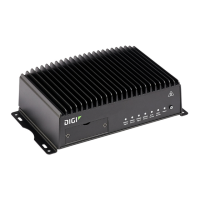Routing Virtual Router Redundancy Protocol (VRRP)
Digi TransPort WR Routers User Guide
187
n On the menu, click Network > Services > QoS. The QoS page appears.
Command line
To show the current QoS configuration use the qos-queue command and the qos-filter command with
no parameters. For example:
digi.router> qos-queue
digi.router> qos-filter
Virtual Router Redundancy Protocol (VRRP)
TransPort devices support Virtual Router Redundancy Protocol (VRRP). VRRP is a standards-based
protocol for managing a network redundancy problem, where a single default gateway on a network
may result in a single point of failure. VRRP enables two or more routers to act as a single group called
a Virtual Router, with one or more routers acting as backup routers in case the master router fails.
Using VRRP, a virtual IP address is shared among the routers in the same group and mapped to the
master router. In the event the master router fails, the backup router with the highest priority takes
over and the virtual IP address is mapped to it. The routers within a group use an election protocol to
dynamically assign the virtual IP address to the router with the highest priority.
For further reading on VRRP, see https://en.wikipedia.org/wiki/Virtual_Router_Redundancy_Protocol.
Configure VRRP protocol
This section describes how to configure VRRPon a TransPort device.
Required configuration items
n Enable VRRP.
n Configure the interface used by VRRP. By default, VRRP is configured to use LAN1.
n Configure the unique Router ID integer between 1 and 255 that identifies this router. It is
configured to 1 by default.
n Configure the initial state for VRRP that this router will start with. It is configured to “backup”
by default.
n Configure the virtual, shared IP address that clients on the LAN will use to connect to this
router.
n Configure the VRRP Priority of this router. It is configured to 100 by default.
n Configure the interval in seconds between 1 and 60 at which this router will broadcast
advertisement packets to other routers in the same group. It is set to 1 by default.
Web
1. If you upgraded the TransPort from a pre-3.1 TransPort system, you need to update some of
the DHCP server settings to allow VRRP to work properly. See Configure the default gateway
and DNS server addresses for VRRP.
2. On the menu, click Network > Services> VRRP. The VRRP page appears.
3. Click the State toggle switch to "on" to turn on the VRRPinstance.

